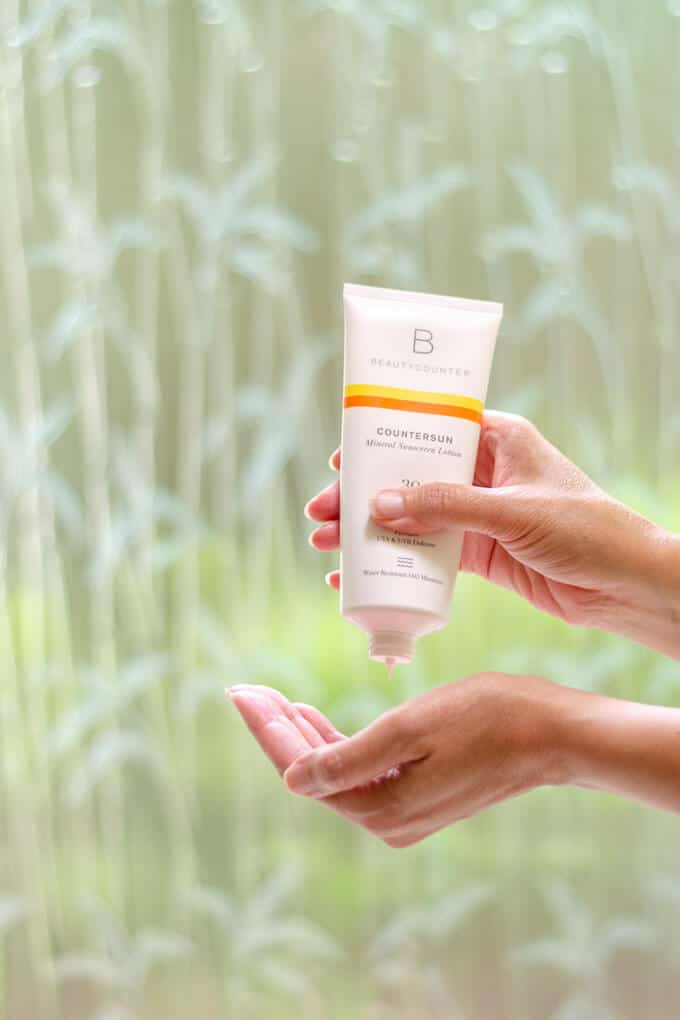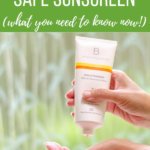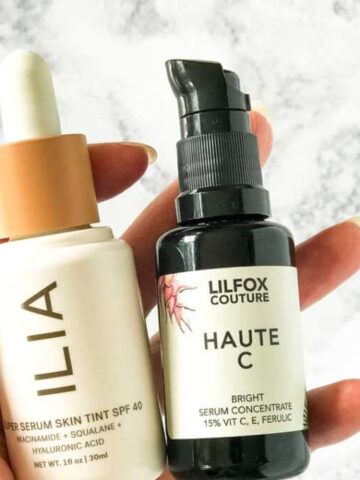You should be able to buy sunscreen without worrying about harmful chemicals. But there are over 80,000 chemicals on the market...and many of them don't have safety data. Here's what you need to know now about the sunscreen ingredients you should (and shouldn't) use.

Want to Save This Post?
Enter your email & I'll send it to your inbox. Plus, get great new recipes from me every week!
If you're anything like me, you try to eat healthy and you shop organic produce whenever possible. But did you know that there are equally (if not more) harmful chemicals in the products you put on your body? Like makeup, skin care products...and even sunscreen!
Sunscreen is an important part of many safe skin care routines. And rightly so! A new study by the Center for Drug Evaluation and Research, an arm of the US Food and Drug Administration shows sunscreen enters your bloodstream after just one day of use.
This post contains affiliate links for your convenience. Please read my disclosure for more info.
Recent research suggests that nearly 90% of melanomas are caused by overexposure to ultraviolet (UV) radiation from either the sun or artificial sources. The American Academy of Dermatology (AAD) has even prioritized educating the public on skin cancer prevention efforts because they see a serious gap in most patients' sun safety knowledge.
Of course, confusing marketing claims also make understanding your sunscreen options more challenging. And with the prevalence of some particular sunscreen ingredients, it will be difficult to find a clean sunscreen on most store shelves. Even if you know what you're looking for!
Thankfully, the FDA's recently proposed rule to update regulations for sunscreen could drastically improve this sticky situation. Not only are they moving to collect more solid research on the health concerns of 12 of the 16 most common sunscreen ingredients, but they are also moving to make labeling easier to understand. Finally!
RELATED: 20 Skin Care Ingredients to Avoid Now
What's the FDA saying about sunscreen ingredients?
In short, they're saying quite a lot. Lucky for you, I've gone through the proposal and pulled out the highlights that you need to know right now about making a smart buying decision.
Essentially, they've broken down the most commonly found active sunscreen ingredients into three categories based on a pool of existing research. These ingredients are being rated according to the 'generally recognized as safe and effective' (GRASE) standards.
So, what's the big deal?
"In recent years, a growing body of data has suggested that the transdermal absorption of some sunscreen active ingredients is greater than previously thought, and thus may raise previously unevaluated safety concerns, including the potential for reproductive, developmental, or carcinogenic effects." - FDA
In other words, they're saying there's research that suggests we're absorbing the active ingredients in our sunscreen. At higher rates than previously thought. And this could be seriously affecting our health in a number of ways.
Yuck.
So, what can you do?
For starters, you'll need to know the 2 active sunscreen ingredients that have already been GRASE-approved. That's right...only 2 out of 16 active sunscreen ingredients that are currently sitting on US shelves have been deemed safe! As it currently stands, the odds of you picking a clean sunscreen are not in your favor.
Here's the scoop on the 2 ingredients you absolutely need to stay away from, the 12 problematic ingredients that require plenty of further testing, and the 2 sunscreen ingredients that you can safely use right now.
The 2 Absolute No-No's of Sunscreen Ingredients
The FDA has deemed these as the Category II sunscreen ingredients. They are absolutely not safe and there's lots of data and research to back that claim up.
Those two ingredients are:
- Para-Aminobenzoic Acid (PABA)
- Trolamine salicylate
Long story short, the risks of these ingredients far outweigh the benefits. Severe allergic and photoallergic dermatitis, gastro distress and liver injury were just a few of the side effects of using these particular ingredients.
Thankfully, these ingredients have already been pulled from most sunscreens on US shelves.
The Jury is Out on These 12 Sunscreen Ingredients
These 12 problematic sunscreen ingredients have been deemed Category III by the FDA. This large group of common active ingredients do not have enough data available to say one way or another if they're safe for use or fit the GRASE standards.
Here's the long list of Category III ingredients:
- Cinoxate
- Dioxybenzone
- Ensulizole
- Homosalate
- Meradimate
- Octinoxate
- Octisalate
- Octocrylene
- Padimate O
- Sulisobenzone
- Oxybenzone
- Avobenzone
The most significant gaps in research are found in the first 10 ingredients in that list. So we just don't know if they're safe or not.
The final two sunscreen ingredients on this list have significantly more safety data gathered on them...but I'm not taking any chances on them!
Here's why:
Oxybenzone
This ingredient is a common organic (chemical) UV filter.
And more than 96 percent of the American population routinely have detectable oxybenzone in their body, according to the Centers for Disease Control.
It has been noted that oxybenzone can also cause product contact and photocontact allergic reactions, a variety of hormone imbalances, and has even been linked to Hirschsprung's disease.
Here's the real problem:
Oxybenzone can be found on the sunscreen ingredient lists of nearly 65 percent of the non-mineral sunscreens in EWG’s database.
And we haven't even mentioned the environmental and aquatic dangers this ingredient poses. Coral reef bleaching, fish mortality, and a variety of other toxic reactions too. And wastewater treatment plants can't effectively remove it during processing.
This is concerning enough that Hawaii has already moved forward in banning it.
Oh. And it's not just sunscreen that you have to watch out for with this ingredient. It can be found in other beauty products. Check your perfumes, hair sprays, lipsticks, and conditioners.
Not good. Not good at all. This is an ingredient that I'm staying far, far away from.
Avobenzone
Like oxybenzone, this ingredient is an organic UV filter. The FDA has noted that there are a number of gaps with this particular sunscreen ingredient as well – more gaps than with oxybenzone.
Still, its chemical properties suggest that products with this ingredient could potentially be absorbed into your body.
Avobenzone also seems to show signs that it degrades more quickly in sun exposure, ultimately decreasing its effectiveness by anywhere between 50 to 90 percent in the 60 minutes following sun exposure.
It's an active sunscreen ingredient that doesn't actually seem to protect you very well from the sun?
What's the point in that?
The 2 Sunscreen Ingredients that are Safe to Use Right Now
Drumroll please for the two active sunscreen ingredients that have been fully vetted by the FDA as GRASE for use in sunscreens. No further testing or research required!
The two safe sunscreen ingredients are:
- Zinc oxide
- Titanium dioxide
These two sunscreen ingredients are known as mineral sunscreens. While oxybenzone and avobenzone are labeled as "organic" active ingredients, these particular ingredients are "inorganic" UV filters.
Why does this matter?
Inorganic filters, like zinc oxide and titanium dioxide, actually offer better broad spectrum protection than organic filters. This is because inorganic filters reflect the radiation, whereas organic filters absorb and convert it.
There is substantial research available on these two sunscreen ingredients. It shows that, even with particles on a nanoscale, you are not at risk for absorbing these active ingredients. And they're the only ones considered reef safe.
5 Sun Products with Safe Sunscreen Ingredients
Elizabeth Buzney, MD, outpatient clinical director of the Department of Dermatology at Brigham and Women’s Hospital and assistant professor of dermatology at Harvard Medical School mentions that she will typically advise her patients with sensitive skin to choose sunscreens containing inorganic ingredients – either zinc oxide and/or titanium dioxide.
Here's my (non-medical) two cents:
I've tested more sunscreens than I can count.
It's really hard to find safe sunscreens that don't irritate my sensitive skin, aren't gloppy, or oily, and don't leave a white cast. At this point, we're basically looking for a four leaf clover!
After much trial and tribulation, here are five zinc oxide sunscreen products that I can wholeheartedly recommend! They also skip unhealthy parabens, petroleum, sulfates, phthalates, and any artificial dyes or fragrances.
Pipette Mineral Sunscreen SPF50
This mineral sunscreen lotion is currently my go-to sunscreen. This formula gives you UVA/UVB broad spectrum coverage with non-nano zinc oxide. I love that it rubs in easily, feels weightless, it's not sticky and it doesn't leave a white residue after application.
This SPF50 lotion is my favorite and the one I use the most. It really feels like a lotion and I can even use it on my face without breaking out. It's perfect for sensitive skin and even children!
How to Use
Using this sunscreen is really simple. Apply generously about 15 minutes before you head out into the sun. Reapply every two hours. If you're swimming (or if you're sweating it out on a run) use a water-resistant sunscreen like the Juice Sport.
Juice Beauty SPF 30 Sport Moisturizer
This water-resistant broad-spectrum mineral sunscreen is a perfect choice if you're active and on the go. This is another one of my preferred non-nano zinc oxide sunscreens. Juice Beauty even packed in some extra antioxidants and essential vitamins too!
The sport formula is thicker and takes longer to rub in, but it's water resistant to 80 minutes. I like this one for snorkeling or if I'm going to be in the water all day.
How to Use
By now you're probably seeing the trend – start by applying a generous layer of sunscreen at least 15 minutes before you step into the sun. This formula is water-resistant for up to 80 minutes and you should also reapply every 80 minutes.
Countersun Mineral Sunscreen Lotion SPF 30
This formula gives you full broad spectrum coverage. It rubs in evenly and leaves you free of white residue after application.
This lotion is another favorite when I want full-body coverage. But I will still use a higher SPF on my face if I'm spending the day outdoors (usually the Pipette sunscreen lotion which offers more sun protection and is easy to reapply frequently).
How to Use
Apply generously about 15 minutes before sun exposure. You'll need to reapply after 40 minutes of water-time. If you're steering clear of the water, reapplying every 2 hours should do the trick!
Ilia Skin Tint SPF 40
This is the face sunscreen I use every day. It comes in 18 different shades (I use Paloma ST9 or Shela ST8 depending on how tan I am) and provides beautiful sheer coverage. It also provides the perfect amount of SPF protection when you're running around town or heading to and from work.
It's made with 12% non-nano zinc oxide to safely protect skin from UVA, UVB, UVC, blue light, and infrared. The ingredients also include skin care serum levels of hyaluronic acid, squalane, and niacinamide to help enhance your skin's hydration and plumpness. I love that this product offers SPF and skin care benefits!
How to Use
Part of why this product has made it into my daily routine is its no-fuss application. You can use it alone or on top of your favorite serum. Because it includes serum, hydration, and SPF it's the perfect one-step morning routine!
Mineral Fusion Brush-On Sun Defense SPF 30
This is the face sunscreen I keep in my bag for touchups. It's a transparent mineral sunscreen powder and brush all-in-one that's perfect for reapplying your sunscreen over makeup.
This powder is the easiest way I've found to reapply sunscreen during the day (which you should be doing every few hours!). I apply the Ilia sunscreen in the morning, then brush this powder on throughout the day for additional sun protection.
How to Use
Brush liberally onto any exposed areas 15 minutes before sun exposure. This sunscreen powder can be worn alone or over makeup.
Final thoughts
And here's the key thing to remember. As Dr. Buzney puts it:
"All sunscreen ingredients are chemicals. A molecule is a chemical. Even the “physical” sunscreens containing zinc and titanium are chemicals."
So the challenge is not in finding a "chemical-free" sunscreen, but actually understanding which active sunscreen ingredients are safe to use on your skin.
Luckily you're now in the know! Armed with this knowledge, you'll be able to confidently choose a safe sunscreen for you and your family.







Leave a Reply